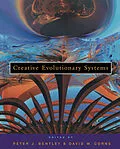The use of evolution for creative problem solving is one of the most exciting and potentially significant areas in computer science today. Evolutionary computation is a way of solving problems, or generating designs, using mechanisms derived from natural evolution. This book concentrates on applying important ideas in evolutionary computation to creative areas, such as art, music, architecture, and design. It shows how human interaction, new representations, and approaches such as open-ended evolution can extend the capabilities of evolutionary computation from optimization of existing solutions to innovation and the generation of entirely new and original solutions.
This book takes a fresh look at creativity, exploring what it is and how the actions of evolution can resemble it. Examples of novel evolved solutions are presented in a variety of creative disciplines. The editors have compiled contributions by leading researchers in each discipline.
If you are a savvy and curious computing professional, a computer-literate artist, musician or designer, or a specialist in evolutionary computation and its applications, you will find this a fascinating survey of the most interesting work being done in the area today.
* Explores the use of evolutionary computation to generate novel creations including contemporary melodies, photo-realistic faces, jazz music in collaboration with a human composer, architectural designs, working electronic circuits, novel aircraft maneuvers, two- and three-dimensional art, and original proteins.
* Presents resulting designs in black-and-white and color illustrations.
* Includes a twin-format audio/CD-ROM with evolved music and hands-on activities for the reader, including evolved images, animations, and source-code related to the text.
* Describes in full the methods used so that readers with sufficient skill and interest can replicate the work and extend it.
* Is written for a general computer science audience, providing coherent and unified treatment across multiple disciplines.
Autorentext
David W. Corne is a reader in evolutionary computation (EC) at the University of Reading. His early research on evolutionary timetabling (with Peter Ross) resultedin the first freely available and successful EC-based general timetabling programfor educational and other institutions. His later EC work has been in suchareas as DNA pattern mining, promoter modeling, phylogeny, scheduling, layoutdesign, telecommunications, data mining, algorithm comparison issues, and multiobjectiveoptimization. Recent funded work (with Douglas Kell) applies EC directlyto the in vivo optimization of proteins. He is an associate editor of the IEEETransactions on Evolutionary Computation and a founding co-editor of the Journal ofScheduling. Dr. Corne is on the editorial boards of Applied Soft Computing and the InternationalJournal of Systems Science, and he serves on a host of international conferenceprogram committees. Other recent edited books include New Ideas in Optimization(with Marco Dorigo and Fred Glover), Telecommunications Optimization: Heuristic andAdaptive Techniques (with Martin Oates and George Smith), and Creative EvolutionarySystems (with Peter Bentley). He is also a director of Evosolve (United Kingdomregistered charity number 1086384, with Jeanne Lynch-Aird, Paul Marrow, GlenysOates, and Martin Oates), a nonprofit organization that promotes the use of advancedcomputation technologies to enhance the quality of life.
Inhalt
PART I - Evolutionary Creativity
Chapter 1 - Creativity in Evolution: Individuals, Interactions, and Environments
By Tim Taylor
Chapter 2 - Recognizability of the Idea: The Evolutionary Process of Argenia
By Celestino Soddu
Chapter 3 - Breeding Aesthetic Objects: Art and Artificial Evolution
By Mitchell Whitelaw
Chapter 4 - The Beer Can Theory of Creativity
By Liane Gabora
PART II Evolutionary Music
Chapter 5 - GenJam: Evolution of a Jazz Improviser
By John A. Biles
Chapter 6 - On the Origins and Evolution of Music in Virtual Worlds
By Eduardo Reck Miranda
Chapter 7 - Vox Populi: Evolutionary Computation for Music Evolution
By Artemis Moroni, Jônatas Manzolli, Fernando Von Zuben, and Ricardo Gudwin
Chapter 8 - The Sound Gallery-An Interactive A-Life Artwork
By Sam Woolf and Adrian Thompson
PART III Creative Evolutionary Design
Chapter 9 - Creative Design and the Generative Evolutionary Paradigm
By John Frazer
Chapter 10 - Genetic Programming: Biologically Inspired Computation That Exhibits Creativity in Producing Human-Competitive Results
By John R. Koza, Forrest H. Bennett III, David Andre, and
Martin A. Keane
Chapeter 11 - Toward a Symbiotic Coevolutionary Approach to Architecture
By Helen Jackson
Chapter 12 - Using Evolutionary Algorithms to Aid Designers of Architectural Structures
By Peter von Buelow
PART IV Evolutionary Art
Chapter 13 - Eons of Genetically Evolved Algorithmic Images
By Steven Rooke
Chapter 14 - Art, Robots, and Evolution as a Tool for Creativity
By Luigi Pagliarini and Henrik Hautop Lund
Chapter 15 - Stepping Stones in the Mist
By Paul Brown
Chapter 16 - Evolutionary Generation of Faces 409
By Peter J. B. Hancock and Charlie D. Frowd
Chapter 17 - The Escher Evolver: Evolution to the People
By A. E. Eiben, R. Nabuurs, and I. Booij
PART V Evolutionary Innovation
Chapter 18 - The Genetic Algorithm as a Discovery Engine: Strange
Circuits and New Principles
By Julian F. Miller, Tatiana Kalganova, Natalia Lipnitskaya, and Dominic Job
Chapter 19 - Discovering Novel Fighter Combat Maneuvers:
Simulating Test Pilot Creativity
By R. E. Smith, B. A. Dike, B. Ravichandran, A. El-Fallah, and R. K. Mehra
Chapter 20 - Innovative Antenna Design Using Genetic Algorithms
By Derek S. Linden
Chapter 21 - Evolutionary Techniques in Physical Robotics
By Jordan B. Pollack, Hod Lipson, Sevan Ficici, Pablo Funes,
Greg Hornby, and Richard A. Watson
Chapter 22 - Patenting of Novel Molecules Designed via Evolutionary Search
By Shail Patel, Ian Stott, Manmohan Bhakoo, and Peter Elliott
